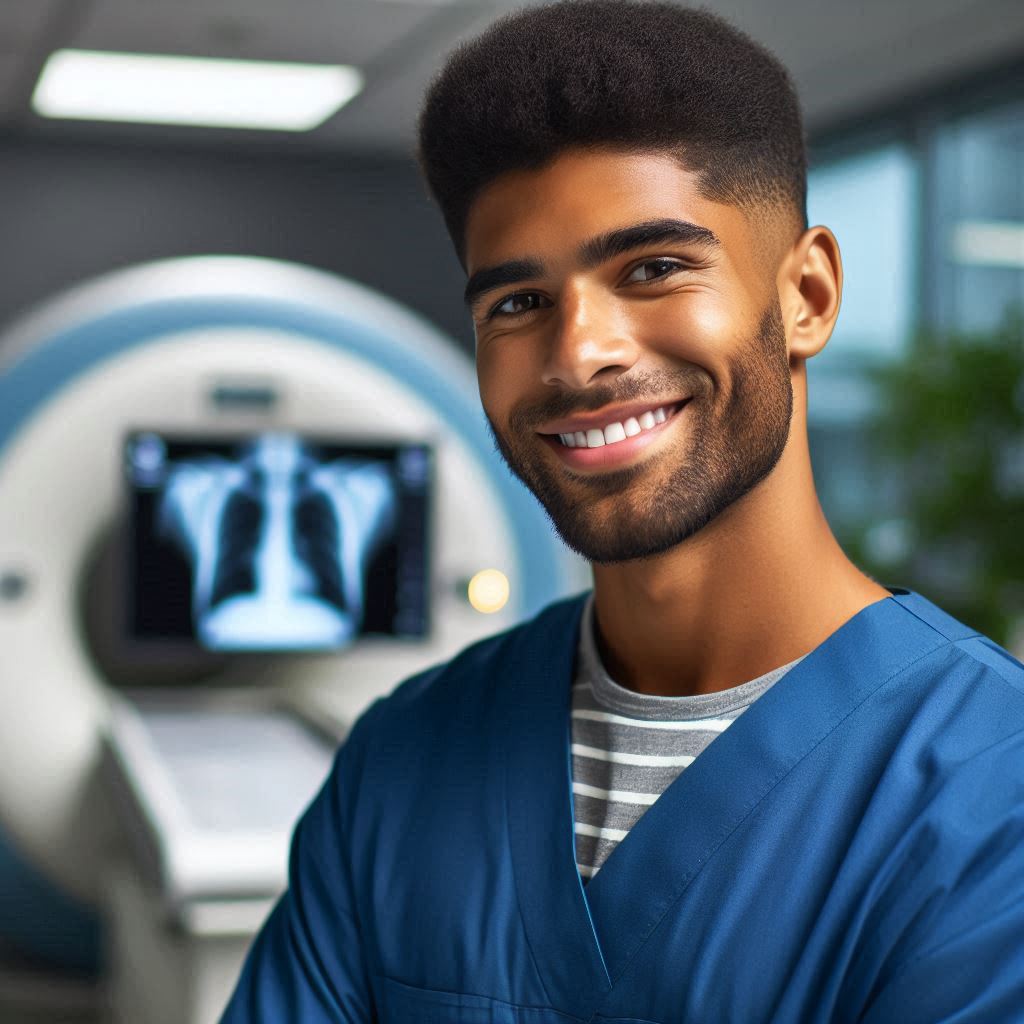Introduction
Radiologic technologists, often referred to as radiographers or x-ray technicians, are essential healthcare professionals responsible for capturing diagnostic medical images using various imaging equipment.
These images help doctors diagnose and treat medical conditions effectively.
Their role is pivotal in the medical field as they assist in detecting illnesses, injuries, and abnormalities through imaging techniques such as x-rays, computed tomography (CT), magnetic resonance imaging (MRI), and mammography.
Radiologic technologists ensure that high-quality images are produced, which are crucial for accurate diagnoses and treatment planning.
This blog post aims to provide a comprehensive overview of the educational requirements necessary to pursue a career as a radiologic technologist.
It will detail the educational path, including academic qualifications, clinical training, licensure, and certifications required to enter and excel in this rewarding healthcare profession.
In subsequent sections, we will delve into each requirement in detail, offering insights into the educational programs available, the skills and competencies developed during training, and the importance of staying current with advancements in medical imaging technology.
High school education requirements
For those aspiring to become radiologic technologists, the journey begins in high school with careful planning and preparation.
This stage is crucial as it sets the foundation for pursuing further education in radiologic technology.
Recommended high school courses for aspiring radiologic technologists
To best prepare for a career in radiologic technology, it is advisable to enroll in rigorous science courses such as biology, chemistry, and physics.
These subjects provide essential knowledge in human anatomy, physiology, and the principles of radiation physics, which are fundamental in the field of radiography.
Pre-requisite courses or GPA requirements
Depending on the program and institution, specific pre-requisite courses may be required for admission.
Courses such as anatomy, medical terminology, and advanced mathematics may be among the requirements.
Additionally, maintaining a competitive GPA is often necessary to meet admission standards, highlighting the importance of academic diligence throughout high school.
Importance of strong foundational knowledge in math and science
A robust understanding of mathematics and sciences forms the cornerstone of radiologic technology education.
Mathematics skills are essential for calculating radiation dosages and interpreting imaging results accurately.
Meanwhile, proficiency in sciences like biology and physics is vital for comprehending the physiological and physical principles underlying radiographic procedures.
By focusing on these foundational areas during high school, aspiring radiologic technologists can better prepare themselves for the rigorous coursework and clinical training required in radiologic technology programs.
Building a solid academic foundation not only enhances the likelihood of admission to preferred programs but also sets the stage for a successful career in this vital healthcare field.
Read: Radiologic Technologist Impact on Radiology Teams
Transform Your Career Today
Unlock a personalized career strategy that drives real results. Get tailored advice and a roadmap designed just for you.
Start NowAssociate’s degree programs
Most radiologic technologists start their education with an associate’s degree program.
These programs are designed to provide students with the foundational knowledge and skills needed to work in the field of radiologic technology.
Coursework typically included in these programs
- Radiographic imaging techniques
- Anatomy
- Patient care
Students will learn how to operate imaging equipment, position patients for imaging procedures, and ensure patient safety during the process.
They will also study anatomy to understand the structure of the human body and how it relates to medical imaging.
Patient care is an essential component of the curriculum, as radiologic technologists often work closely with patients to explain procedures and ensure their comfort.
Average duration of an associate’s degree program for radiologic technology:
Associate’s degree programs in radiologic technology typically take about two years to complete.
This timeframe includes both classroom instruction and hands-on clinical experience, where students work in healthcare settings to gain real-world experience in performing imaging procedures and working with patients.
Bachelor’s degree options
When it comes to pursuing a career as a Radiologic Technologist, individuals have several education options available to them.
While an associate’s degree is the minimum requirement for entry-level positions, some may choose to further their education by obtaining a bachelor’s degree in radiologic technology.
Below, we will discuss the various aspects of pursuing a bachelor’s degree in this field.
Some individuals may choose to pursue a bachelor’s degree in radiologic technology for advanced career opportunities
Choosing to pursue a bachelor’s degree in radiologic technology can open up a world of possibilities in terms of career advancement and specialized knowledge.
While an associate’s degree provides a solid foundation in the field, a bachelor’s degree takes education to the next level.
One of the main reasons individuals decide to pursue a bachelor’s degree is for the increased career opportunities that come with advanced education.
With a bachelor’s degree, radiologic technologists may be eligible for supervisory roles, teaching positions, or specialized areas of practice within the field.
Additional coursework and clinical experience required for a bachelor’s degree
In addition to the standard coursework required for an associate’s degree, bachelor’s degree programs in radiologic technology often include advanced courses in areas such as radiographic physics, advanced imaging techniques, and healthcare management.
These courses are designed to deepen students’ understanding of the field and prepare them for higher-level positions.
Clinical experience is also a crucial component of a bachelor’s degree program in radiologic technology.
Students will have the opportunity to put their knowledge into practice in a real-world setting, working alongside experienced technologists and healthcare professionals.
Showcase Your Business Today
Reach thousands of readers actively exploring professional services. Publish your business profile and grow your audience now.
Publish NowThis hands-on experience is invaluable in preparing students for the demands of a career in radiologic technology.
Specific skills or knowledge gained through a bachelor’s degree program
Specific skills and knowledge gained through a bachelor’s degree program can give individuals a competitive edge in the job market.
Employers often seek candidates who have a deeper understanding of radiologic technology and related disciplines, as well as strong critical thinking and problem-solving skills.
A bachelor’s degree can help develop these skills and demonstrate a commitment to excellence in the field.
In short, pursuing a bachelor’s degree in radiologic technology can be a wise investment in one’s future career.
With advanced coursework, hands-on clinical experience, and specialized skills, individuals can position themselves for success in a competitive job market and open doors to exciting new opportunities within the field.
Read: What Does a Radiologic Technologist Do Daily?
Clinical experience requirements
Obtaining clinical experience is a vital component of a radiologic technologist’s education.
It allows students to apply the knowledge they have gained in the classroom to real-world scenarios, preparing them for the demands of the job.
Importance of hands-on experience
Working directly with patients, equipment, and healthcare professionals helps students develop essential skills such as communication, critical thinking, and problem-solving.
It also gives them the opportunity to practice proper positioning techniques and radiation safety protocols.
Clinical experience provides a unique learning environment where students can observe and participate in various diagnostic imaging procedures.
This exposure allows them to understand the intricacies of different imaging modalities and equipment, enhancing their overall competency as future radiologic technologists.
Number of clinical hours required
Each certification or licensure program has specific requirements for the number of clinical hours students must complete.
These hours are typically outlined by accrediting bodies and regulatory agencies to ensure that students have gained adequate practical experience.
The number of clinical hours can vary depending on the level of certification or licensure being pursued.
For example, entry-level programs may require fewer clinical hours compared to advanced or specialized programs.
Examples of clinical settings
Students have the opportunity to complete their clinical training in a variety of settings, including:
- Hospitals: Teaching hospitals and medical centers offer a diverse range of imaging services and patient populations for students to work with.
- Imaging centers: Specialized facilities focused on diagnostic imaging services, such as X-rays, MRI, CT scans, and mammography.
- Outpatient clinics: Community-based clinics that provide imaging services on an outpatient basis, catering to a specific patient demographic.
Each clinical setting offers unique experiences and challenges for students to navigate, contributing to their overall growth and development as radiologic technologists.
The diversity of settings also allows students to explore different areas within the field and discover where their interests and strengths lie.
Read: Radiologic Technologist Collaboration in Healthcare

Certification and licensure requirements
Obtaining certification and licensure is crucial for radiologic technologists to practice professionally and legally in the field of radiologic technology.
Importance of Certification
Obtaining certification from the American Registry of Radiologic Technologists (ARRT) or other relevant licensing bodies demonstrates a technologist’s competence and commitment to high-quality patient care.
Exams and Requirements
To become certified or licensed in radiologic technology, individuals must pass the relevant exams, such as the ARRT certification exam.
These exams test the technologist’s knowledge, skills, and abilities in the field.
In addition to passing the exams, candidates must meet specific educational and clinical requirements to qualify for certification or licensure.
These requirements ensure that technologists have received adequate training and are prepared to work effectively in a clinical setting.
Continuing Education Requirements
After obtaining certification or licensure, radiologic technologists must fulfill continuing education requirements to maintain their credentials.
Continuing education helps technologists stay up-to-date with the latest advancements in technology, equipment, and best practices in the field.
The ARRT requires technologists to complete a certain number of continuing education credits every two years to renew their certification.
This ensures that technologists are continuously improving their skills and knowledge to provide the best possible care for their patients.
In addition to continuing education requirements, technologists must adhere to the ARRT’s Standards of Ethics to maintain their certification.
These standards outline the professional behavior expected of technologists and ensure that they uphold the highest standards of integrity and patient care.
Overall, obtaining certification and licensure, as well as fulfilling continuing education requirements, is essential for radiologic technologists to provide safe and effective care to their patients and to advance in their careers in the field of radiologic technology.
Read: Technological Advances in Podiatry: Tools and Techniques
Continuing education opportunities
Continuing education is crucial for radiologic technologists to stay updated with the latest advancements in technology and techniques in the field.
By pursuing further education, technologists can enhance their skills, expand their knowledge, and improve their job prospects.
Advanced Certifications and Specialization
One of the ways radiologic technologists can advance their careers is by obtaining advanced certifications or specializing in specific areas such as MRI or CT scanning.
These specialized certifications can increase their marketability and open up opportunities for higher-paying positions.
Obtaining certifications in areas like MRI or CT scanning demonstrates a technologist’s expertise and dedication to their profession.
Showcase Your Business Today
Reach thousands of readers actively exploring professional services. Publish your business profile and grow your audience now.
Publish NowIt also allows them to work in specialized settings and perform advanced procedures, which can lead to a more fulfilling career.
Professional Organizations Offering Continuing Education
There are several professional organizations that offer continuing education resources for radiologic technologists.
These organizations provide access to conferences, seminars, webinars, and online courses that cover various topics in radiology and imaging technology.
Some of the prominent organizations that offer continuing education opportunities for radiologic technologists include the American Society of Radiologic Technologists (ASRT), the Radiological Society of North America (RSNA), and the Society of Diagnostic Medical Sonography (SDMS).
Continuing education is essential for radiologic technologists to stay competitive in the rapidly evolving field of medical imaging.
By exploring the options for further education, pursuing advanced certifications, and taking advantage of resources provided by professional organizations, technologists can enhance their skills, advance their careers, and ensure they are providing the best possible care for patients.
Career outlook and advancement opportunities
Starting a career as a radiologic technologist can lead to a promising future in the healthcare industry.
Radiologic technologists play a crucial role in diagnosing and treating patients through the use of medical imaging technology.
Here, we will explore the career outlook and advancement opportunities for radiologic technologists.
Job Growth and Demand
The demand for radiologic technologists is expected to grow faster than average in the healthcare industry.
As the population continues to age, there will be an increased need for diagnostic imaging to identify and treat various medical conditions.
According to the Bureau of Labor Statistics, employment of radiologic technologists is projected to grow by 7% from 2019 to 2029.
This growth rate is faster than the average for all occupations, which is mainly due to the increasing prevalence of chronic conditions such as heart disease and cancer.
Career Paths and Advancement Opportunities
Experienced radiologic technologists have a variety of career paths and advancement opportunities available to them.
Some common career paths include specializing in areas such as MRI, CT, mammography, or interventional radiology.
With additional certification and training, technologists can advance to supervisory or managerial roles within imaging departments.
They can also choose to become educators, teaching future radiologic technologists at educational institutions.
Average Salary Range
The average salary for radiologic technologists varies based on experience, specialization, and geographic location.
According to the Bureau of Labor Statistics, the median annual wage for radiologic technologists was $62,280 in May 2020.
Technologists with advanced certifications or specializations typically earn higher salaries.
For example, MRI technologists and CT technologists tend to earn more than general radiologic technologists due to the specialized nature of their roles.
In a nutshell, a career as a radiologic technologist offers a stable job outlook with plenty of opportunities for advancement.
With continuous learning and professional development, technologists can grow their careers and make a positive impact on patient care in the healthcare industry.
Conclusion
Aspiring radiologic technologists must complete a formal education program. Most programs require a minimum of an associate’s degree in radiography.
These programs include coursework in anatomy, pathology, radiation physics, and patient care.
Hands-on clinical experience in a hospital or imaging facility is also essential. Upon completion of the program, graduates are eligible to take the certification exam.
Certification is typically required by employers and may include additional education or training.
Continuing education is crucial to maintain certification and stay updated on industry advancements.
Some technologists may choose to pursue a bachelor’s or master’s degree for career advancement.
Specialized certifications in areas like mammography or CT scanning may also be beneficial.
Overall, the educational requirements for radiologic technologists are rigorous but rewarding.
In summary, radiologic technologists need at least an associate’s degree in radiography.
Obtaining the necessary education and training is crucial for success in this field.
Readers are encouraged to research further and consider their own educational goals in radiologic technology.
[E-Books for Sale]
The Big Book of 500 High-Paying Jobs in America: Unlock Your Earning Potential
$19.99 • 500 High-Paying Jobs • 330 pages
Explore 500 high-paying jobs in America and learn how to boost your career, earn more, and achieve success!
See All 500 High-Paying Jobs of this E-Book
1001 Professions Without a Degree: High-Paying American Jobs You Can Start Now
$19.99 • 1001 Professions Without a Degree • 174 pages
Discover 1001 high-paying jobs without a degree! Unlock career tips, skills, and success strategies for just $19.99!




